Chapter 8 Sociolinguistics.ppt
语言学导论第八章
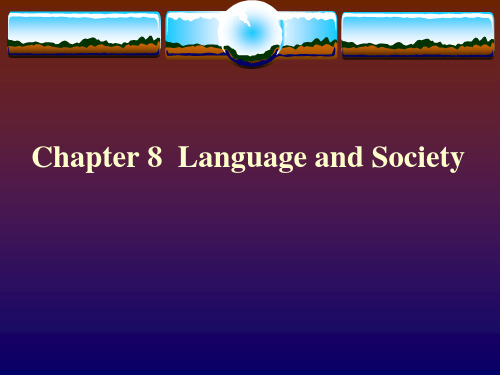
Chapter 8 Language and Society
sociolinguistics社会语言学 --- the study of the relation between language and society
Preliminaries: 1.Find out the differences between male and female languages. 2.Try to discover the distinctions between the language of the younger generation and that of the older generation in China. 3.Think of some examples of code-mixing in the speech of Cantonese.
nguage and age c.jargon: doctor’s language lawyer’s language computational language (Part of a conversation between a judge and a sailor) … The judge: You mean you came into this court as a witness and don’t know what plaintiff means? … The sailor: You mean you came into the court and don’t know where abaft the binnacle is?
speech community言语社区 --- a group of people who have the opportunity to interact with each other and who share not just a single language with its related varieties but also attitudes toward linguistic norms
超全sociolinguistics
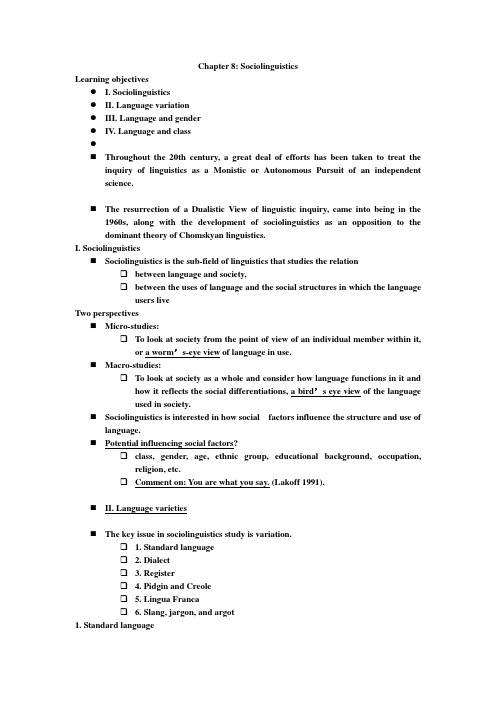
Chapter 8: SociolinguisticsLearning objectives●I. Sociolinguistics●II. Language variation●III. Language and gender●IV. Language and class●⏹Throughout the 20th century, a great deal of efforts has been taken to treat theinquiry of linguistics as a Monistic or Autonomous Pursuit of an independent science.⏹The resurrection of a Dualistic View of linguistic inquiry, came into being in the1960s, along with the development of sociolinguistics as an opposition to the dominant theory of Chomskyan linguistics.I. Sociolinguistics⏹Sociolinguistics is the sub-field of linguistics that studies the relation❑between language and society,❑between the uses of language and the social structures in which the language users liveTwo perspectives⏹Micro-studies:❑To look at society from the point of view of an individual member within it, or a worm’s-eye view of language in use.⏹Macro-studies:❑To look at society as a whole and consider how language functions in it and how it reflects the social differentiations, a bird’s eye view of the languageused in society.⏹Sociolinguistics is interested in how social factors influence the structure and use oflanguage.⏹Potential influencing social factors?❑class, gender, age, ethnic group, educational background, occupation, religion, etc.❑Comment on: You are what you say. (Lakoff 1991).⏹II. Language varieties⏹The key issue in sociolinguistics study is variation.❑ 1. Standard language❑ 2. Dialect❑ 3. Register❑ 4. Pidgin and Creole❑ 5. Lingua Franca❑ 6. Slang, jargon, and argot1. Standard language⏹George Bernard Shaw, Pygmalion⏹ A particular variety of a language is better than any other.⏹This dominant, or prestigious variety is often called standard variety orstandard language/dialect⏹Quote: A language is a dialect with an army and navy.⏹Question: what is the definition of the standard language in China?⏹普通话的定义:❑以北京语音为标准音, 以北方话为基础方言, 以典范的现代白话文著作为语法规范的现代汉民族共同语。
sociolinguistics
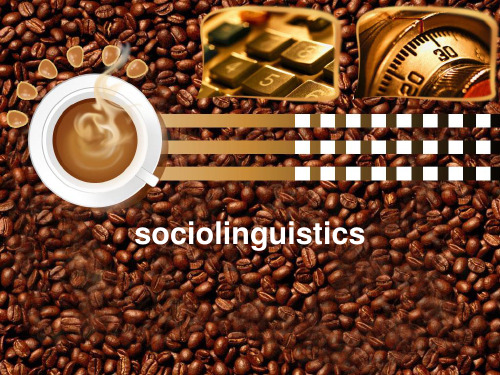
• One of the principal uses of language is to communicate meaning, but it is also used to establish and to maintain social relationships. • It is the second function of language use that sociolinguists study.
• Regional/geographical dialects: • Varieties of a language spoken in a geographical area, such as Cockney dialect, and Yorkshire dialect in Britain, or North Midland dialect and South Midland dialect in the United States, and Guangdong dialect in China.
• Sociolects and standard dialects are often confused because they are interpreted only in terms of prestige. • In due course the sociolect with the highest status in a country often acquires the status of the standard dialect.
• A regional dialect is a variation of language different enough to be classed as a separate entity, but not different enough to be classed as a separate language. • Sometimes a dialect rises in status and becomes the standard variety of a country, becoming standard dialect, e.g. standard English, standard Chinese.
英语语言学概论第八章笔记
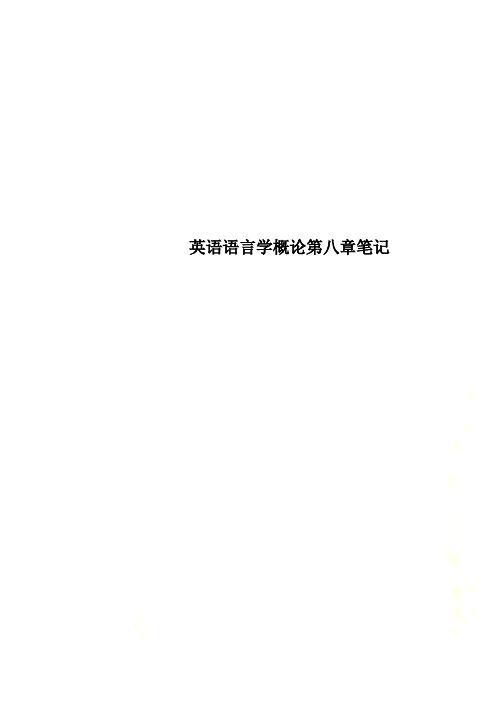
英语语言学概论第八章笔记Chapter 8 Socio-linguistics 社会语言学1.What is socio-linguistics? 什么是社会语言学?Sociolinguistics is the sub-discipline of linguistics that studies language in social contexts.社会语言学是语言学的一个分支,它研究社会环境中的语言。
nguage variation 语言变异a)S peech community 言语社区In sociolinguistic studies, speakers are treated as members of social groups. The social group isolated for any given study is called speech community. A speech community thus defined as a group of people who form a community (which may have as few members as a family or as many member as a country), and share the same language or a particular variety of language. The important characteristic of a speech community is that the members of the group must, in some reasonable way, interact linguistically with other members of the community. They may share closely related language varieties, as well as attitudes toward linguistic norms.社会语言学研究中,说话者被当作是社会群体的成员。
Sociolinguistics.ppt
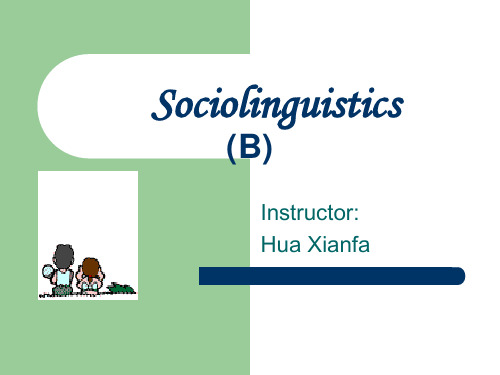
(B)
Instructor: Hua Xianfa
Chapter III Language and Context
3.1. Varieties of language related to the use 3.1.1. Speech repertoire(言语语库) In any speech community there is no single style
speaker. Any individual controls a number of varieties of a language or of two or more language, that is, he or she has a speech repertoire. “A speech repertoire is the range of linguistic varieties which the speaker has at his disposal and which he may appropriately use as a member of his speech community.”(Platt and Platt)
r of discourse(话语意旨)
Tenor of discourse refers to the role of relationship in the situation in question: who the participants in the communication group are and in what relationship they stand to each other. It answers the question of “to whom ” the speaker is communicating. This dimension to a great extent determines the level of formality and the level of technicality of the language we use.
Sociolinguistics
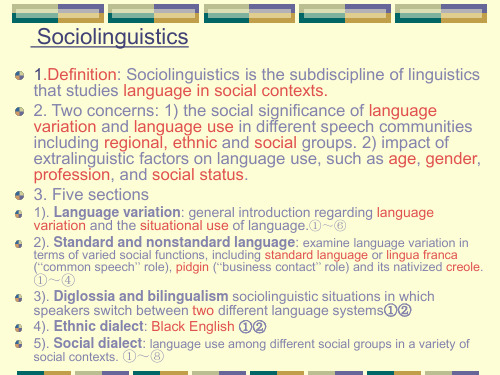
1.Definition: Sociolinguistics is the subdiscipline oguage in social contexts. 2. Two concerns: 1) the social significance of language variation and language use in different speech communities including regional, ethnic and social groups. 2) impact of extralinguistic factors on language use, such as age, gender, profession, and social status. 3. Five sections
1. Two definitions: 1) A speech community: a group of people who form a community and share the same language or a particular variety of language. 2) A social group: besides regionally, a social group may distinguish
Contents: 1. Speech community 2. Speech variety 3. Regional variation 4. Social variation 5. Stylistic variation 6. Idiolectal variation
Speech community
3. Language variation → → → → 1. Education varieties 4. Social dialect → →Age varieties 2. 3. Gender varieties 5. Ethnic dialect 4. Register varieties
《新编简明英语语言学教程》PPT课件

Chomsky’s definition (1957)
“From now on I will consider language to be a
set of (finite or infinite) sentenБайду номын сангаасes, each finite in length and constructed out of a finite set of elements.”
• • • • •
Arbitrariness Productivity/Creativity Duality Displacement Cultural transmission
Arbitrariness
----No logical (motivated or intrinsic) connection between sounds and meanings. Onomatopoeic words (which imitate natural sounds) are somewhat motivated ( English: rumble, crackle, bang, …. Chinese: putong, shasha, dingdang… ) Some compound words are not entirely arbitrary, e.g. type-writer, shoe-maker, air-conditioner, photocopy…
Language is arbitrary
Arbitrary---- no intrinsic connection between the word and the thing it denotes, e.g. “pen” by any other name is the thing we use to write with.
Sociolinguistics and language teaching 优质课件
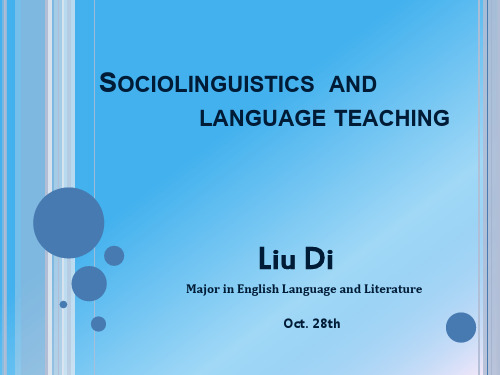
Social system Semantic networks Grammatical system
Why should we teach cultural things in our classroom?
4) Culture is always reflected in language and there is no separation between understanding language and understanding culture.
1) Due attention should be paid to sociological and cultural studies.
2) Cultural study can arose great interest of language learners in language leaning.
Selection to produce a certain social meaning
Linguistic theory is concerned primarily with an ideal speaker-listener, in a completely homogeneous speech community, who knows its language perfectly and is unaffected by such grammatically irrelevant conditions as memory limitations, distractions, shifts of attention and interest, and errors (random or characteristic) in applying his knowledge of the language in actual performance.
chapter 8 Sociolinguistics
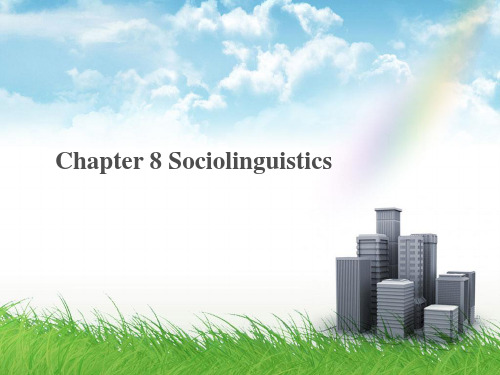
2.3 Registers 语域 Registers are also marked by syntactic variables:
I should be grateful to you if you would make less noise. Please be quiet.
Shut up.
The use of an inappropriate register is one
Chapter 8 Sociolinguistics
Contents
1. Introduction 2. Language Varieties
3. Choosing a Code }4. Linguistic Taboos and Euphemisms 5. Language and Gender
2.3 Registers 语域 We speak in different ways on different occasions. These varieties classified according to use are called registers. Registers can differ in vocabulary, phonology, grammar and semantics. (Classroom register --- dorm register)
classed as a separate entity, but not different
enough to be classed as a separate language. (Tianjing dialect --- Wuhan dialect)
When a dialect is standardized and given the status by the authority, it has become the standard variety of a country.
Chapter 8 Sociolinguistics
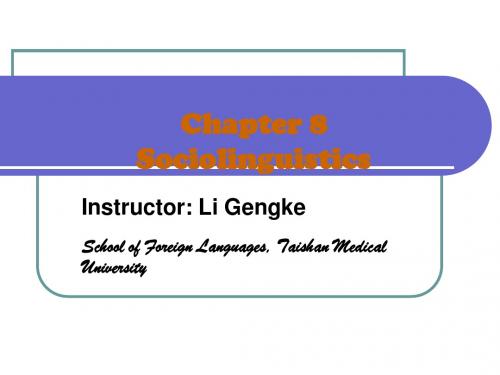
Temporal dialects varieties of a language used at particular stages in its historical development. There are two major temporal dialects in Chinese — classical Chinese and modern Chinese. In English, there are marked differences between Old English and Middle English, and between Middle English and Modern English.
Many linguists have tried to work out theories to describe the relationship between social variables and linguistic features. A well-known version of these theories is M. A. K. Halliday’s register theory.
When we study language in relation to society, it is called sociolinguistics. In sociolinguistics we are interested in how social factors influence the structure and use of language. It is the field that studies the relations between language and society, between the uses of language and the social structures in which the users of language live. It is also a field of study that assumes that human society is made up of many related patterns and behaviors, some of which are linguistic.
自考本科英语语言学Chapter8LanguageAndSociety
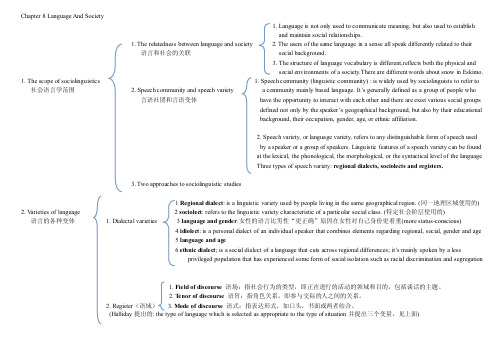
Chapter 8 Language And Society1. Language is not only used to communicate meaning, but also used to establishand maintain social relationships.1. The relatedness between language and society2. The users of the same language in a sense all speak differently related to their语言和社会的关联social background.3. The structure of language vocabulary is different,reflects both the physical andsocial environments of a society.There are different words about snow in Eskimo.1.The scope of sociolinguistics 1. Speech community (linguistic community) : is widely used by sociolinguists to refer to社会语言学范围 2. Speech community and speech variety a community mainly based language. It’s generally defined as a group of people who言语社团和言语变体have the opportunity to interact with each other and there are exist various social groupsdefined not only by the speaker’s geographical background, but also by their educationalbackground, their occupation, gender, age, or ethnic affiliation.2. Speech variety, or language variety, refers to any distinguishable form of speech usedby a speaker or a group of speakers. Linguistic features of a speech variety can be foundat the lexical, the phonological, the morphological, or the syntactical level of the languageThree types of speech variety: regional dialects, sociolects and registers.3. Two approaches to sociolinguistic studies1 Regional dialect: is a linguistic variety used by people living in the same geographical region. (同一地理区域使用的)2.V arieties of language 2 sociolect: refers to the linguistic variety characteristic of a particular social class. (特定社会阶层使用的)语言的各种变体 1. Dialectal varieties 3 language and gender.女性的语言比男性“更正确”原因在女性对自己身份更看重(more status-conscious)4 idiolect: is a personal dialect of an individual speaker that combines elements regarding regional, social, gender and age5 language and age6 ethnic dialect; is a social dialect of a language that cuts across regional differences; it’s mainly spoken by a lessprivileged population that has experienced some form of social isolation such as racial discrimination and segregation1. Field of discourse语场:指社会行为的类型,即正在进行的活动的领域和目的,包括谈话的主题。
Language_and_society
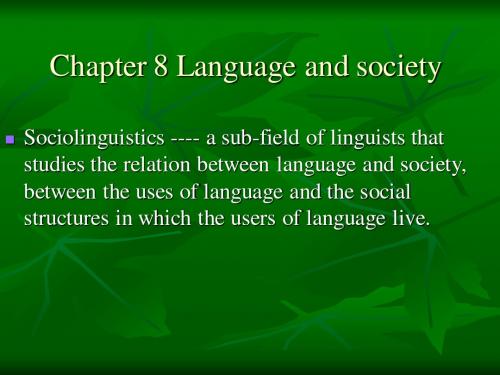
Degree of formality
----Five ----Five stages of formality (Martin Joos) Intimate: Up you go, chaps! Casual: Time you all went upstairs now. Consultative: Would you mind going upstairs right away, please? Formal: Visitors should go up the stairs at once. Frozen: Visitors would make their way at once to the upper floor by way of the staircase. ----Note: ----Note: Different styles of the same language can be characterized through differences at three levels: syntactic, levels: lexical and phonological(P121). phonological(P121)
Varieties of language
dialects (the user) Varieties registers (use)
Dialect vs. Language
Dialect: A dialect is a subordinate variety of a Language.
Texas English, Swiss German are, respectively, dialects of English and German. In Chinese, we have Sichuan dialect, Shandong dialect, Henan dialect, etc.
英语语言学概论第八章笔记

Chapter 8 Socio-linguistics 社会语言学1.What is socio-linguistics? 什么是社会语言学?Sociolinguistics is the sub-discipline of linguistics that studies language in social contexts.社会语言学是语言学的一个分支,它研究社会环境中的语言。
nguage variation 语言变异a)Speech community 言语社区In sociolinguistic studies, speakers are treated as members of social groups. The social group isolated for any given study is called speech community. A speech community thus defined as a group of people who form a community (which may have as few members as a family or as many member as a country), and share the same language or a particular variety of language. The important characteristic of a speech community is that the members of the group must, in some reasonable way, interact linguistically with other members of the community. They may share closely related language varieties, as well as attitudes toward linguistic norms.社会语言学研究中,说话者被当作是社会群体的成员。
Sociolinguistics
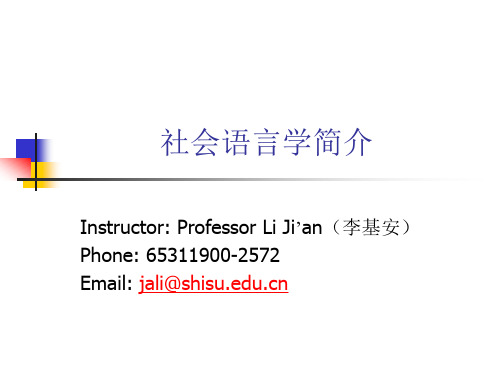
引言
社会语言学是一门年轻的学科,从确立 至今只有 40年左右的历史,但却因其独 特的学科性质和极强的发展能力而备受 关注。 社会语言学的确立以1964年在美国召开 的第9届国际语言学大会为标志。
历史背景
考察语言问题需结合社会因素的思想在 中西学术史中早已有之。 但直到18、19世纪、语言的社会性质才 真正引起人们的重视。有关语言和社会 关系的论述开始出现在一些著名学者的 文章、著作中。
主要流派
社会方言学(social dialectology) 语言社会学(sociology of language) 交际民族志学(ethnopology of communication) 语言社会心理学(social psychology of language) 互动社会语言学(interactional sociolinguistics)
而且成为许多大学语言学系的专业课程, 得到了学术界的普遍承认。
历史背景
就连当初把社会语言学研究比喻为采集蝴蝶标 本的工作,认为其重要性无法同理论语言学相 提并论的乔姆斯基,最后也改变了看法,声称 从不怀疑社会语言学研究在语言科学中的合法 地位。 当代社会语言学的应用研究在法律、广告、诊 断、教育等领域内广泛开展,已经成为社会文 化的有机组成部分之一,引起了越来越多的关 注。
主要流派
互动社会语言学(interactional sociolinguistics)
曾被译为“交际社会语言学”或“相互交往社 会语言学” 会话过程绝不是一个简单的罗列词语的过程。 研究语言和非语言知识在会话过程中的作用以 及说话人的社会文化背景如何跟这些知识相互 影响。
Sociolinguistics.ppt
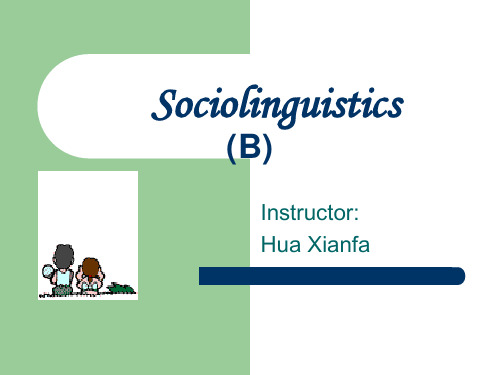
Tenor of discourse(话语意旨)
Tenor of discourse refers to the role of relationship in the situation in question: who the participants in the communication group are and in what relationship they stand to each other. It answers the question of “to whom ” the speaker is communicating. This dimension to a great extent determines the level of formality and the level of technicality of the language we use.
Three social variables that determine the register
Field of discourse(话语范围) Field of discourse is the linguistic reflection of the
purpose role of the language user in the situation in which a text has occurred. In other words, it is concerned with the purpose and subject-matter of communication. It answers the question of ‘Why’ and ‘About what’ communication takes place. Field of discourse may be non-technical or technical. Shopping, game-playing and a personal letter are instances of non-technical fields. Technical fields refer to the specialist fields such as a linguist giving a lecture in class and meteorologists talking about the weather.
chapter 8 sociolinguistics 英语专业语言学PPT

Language varieties are related to region, social ass, educational background, and the degree of formality of a situation in which language is used, including standard language, dialects, registers, pidgins, creoles, etc.
Horizontal bilingualism (横向性双语现 象) & diagonal bilingualism (倾斜性 双语现象)
Multilingualism
A situation where 3 or more languages are used by an individual or by a group of speakers.
Chapter 8 Sociolinguistics
Language is a city to the building of which every human being brought a stone. ——Ralph Waldo Emerson
Once you open your mouth, you are placed. —— Pygmalion by Bernard Shaw
The origin of the name
➢ -- Hebrew pidjom meaning “trade or exchange” -- Chinese characters pei and ts'in meaning “paying money”
语言与社会
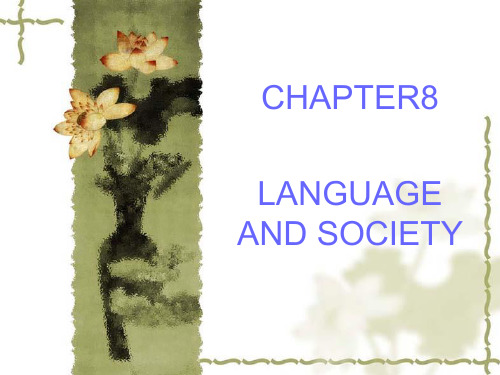
语言的变体举例:
❖ 地域方言(Regional dialect) ❖ 地域方言是语言因地域方面的差别而形成的变体,
是全民语言的不同地域上的分支,是语言发展不平 衡性而在地域上的反映。 ❖ 地域方言的差别是很大的,许多语言都存在着无法 相互通话的地域方言。事实上,地域方言与独立语 言之间是没有明确的界限的,有许多地域变体(例 如汉语的地域变体),究竟是方言还是独立语言都 存在争议。
Varieties of language
语言变体
❖ 语言变体,又称语言或言语变异、语言或言语异体。语言变 体是社会语言学研究的重要课题。R.A.赫德森(Richard Hudson)把语言变体定语为“社会分布相似的一套语项”。 意指是由具备相同社会特征的人在相同的社会环境中所普 遍使用的某种语言表现形式。“语言变体”是一个内涵很 宽泛的概念,大至一种语言的各种方言,小至一种方言中 某一项语音、词汇或句法特征,只要有一定的社会分布的 范围,就是一种语言变体。 语言的变体受到复杂的社会因 素制约,社会语言学对语言变体的研究一般认为,讲话人 的社会阶级(Class)和讲话风格(Style)是语言变体的重 要基础,而讲话人的性别对语言变体也产生重要影响。根 据使用者来划分的变体叫方言,根据语言使用来划分的变 体叫语体或语域。
词语可以指标准语(standard language)、方言(dialect)、洋 径浜语(pidgin)、克里奥 尔语(creole)等, 可以指同一语言的 地域性或民族性变体, 如英语中的澳大利亚英语、黑 人英
语等, 也可以指同属一种语言的功能性言语变体,如法律语
体等。 社会语言学家尤其是对地域变体(又称地域方言)、
CHAPTER8
LANGUAGE AND SOCIETY
自考 chapter 8 Sociolinguistics
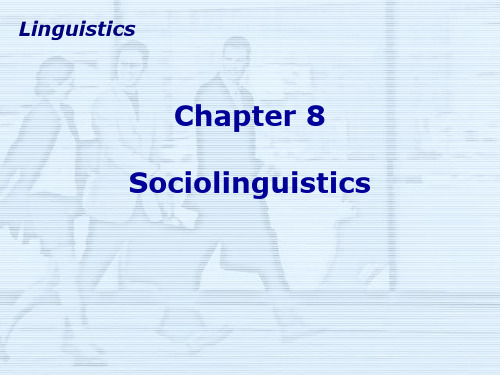
• • • • •
Example 1 (Ray, a student, comes home after school.) Ray: Hi, mum. Mum: Hi. You‟re late. Ray: Yeah, that bastard Sootbucker Kept us in again. • Mum: Nana‟s here. • Ray: Oh sorry. Where is she? • • • • • Example 2 (Leaving school, Ray runs into the school principal.) Ray: Good afternoon, sir. Principal: What are you doing here at this time? Ray: Mr. Sutton kept us in, sir.
• Linguistic phenomena are placed in the general context of society. • People‟s use of language is in part determined by his social background.
8.1.1 Speech community (言语社团)
8.1.3.1 Geographical variation
Geographical variation, which refers to the variation of languБайду номын сангаасge across geographical regions, can be generally divided into international variation and regional dialects. International variation refers to the variation of a language among different nations and is best exemplified by the American English and British English. Regional dialect denotes the variations within one country.
